Introduction
As organizations increasingly pivot towards cloud-based solutions, understanding the intricacies of the AWS Cloud Stack becomes paramount. This comprehensive suite of services from Amazon Web Services offers businesses the tools necessary to build, manage, and optimize their cloud infrastructures effectively.
With projections indicating that a significant portion of data will reside in the cloud by 2025, the relevance of the AWS Cloud Stack cannot be overstated. It not only facilitates enhanced scalability and cost efficiency but also addresses critical security concerns that arise in today’s data-driven landscape.
This article delves into the core components of the AWS Cloud Stack, its myriad benefits, best practices for management, and the challenges organizations may encounter, providing a roadmap for navigating the complexities of cloud technology.
Defining AWS Cloud Stack: An Overview
The AWS Cloud Stack is a robust suite of services and resources provided by Amazon Web Services (AWS), which enables entities to effectively build and manage cloud-based applications and infrastructures. This integrated platform encompasses essential components such as computing power, storage solutions, and networking capabilities, all engineered for seamless operation. The significance of the AWS Cloud Stack cannot be overstated, as it enables businesses to utilize technology for improved scalability, flexibility, and cost efficiency—transforming the deployment and management of IT resources.
As we approach 2025, projections indicate that:
- 50% of data will reside in remote servers.
- 89% of organizations are already utilizing multi-cloud solutions.
The AWS Cloud Stack is essential for companies looking to navigate this evolving landscape. Significantly, 54% of sensitive information is encrypted among companies that store data offsite, highlighting the importance of security in data management. Additionally, with 80% of businesses utilizing hybrid solutions, AWS plays a vital role in supporting these operational models.
Cody Slingerland observes that, > The U.S. and Western Europe still dominate computing services <, highlighting the continuing importance of AWS in global markets. Furthermore, AWS's expansion into over 200 services, its acquisition of 32% of global spending in Q3 2022, and the planned launch of Local Zones in 32 metropolitan areas exemplify its leadership and commitment to enhancing service availability and performance across various sectors.
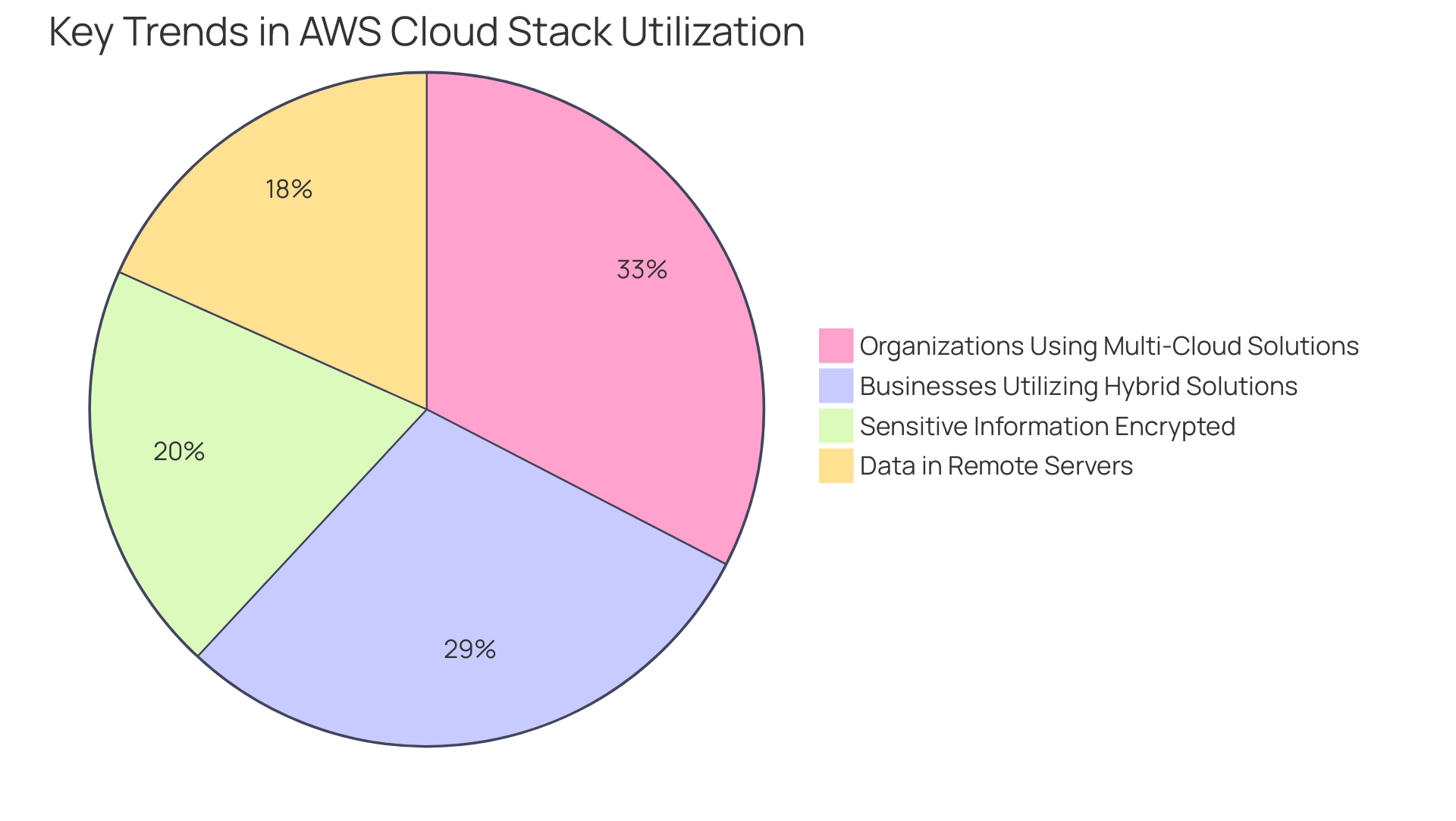
Key Components of an AWS Cloud Stack
The aws cloud stack is a comprehensive framework that includes several key components essential for effective operations in the network. As the public platform as a service (PaaS) revenue is projected to reach 172 billion U.S. dollars in 2024, the importance of online services continues to grow.
- Compute Services: At the heart of this stack is Amazon EC2, which delivers scalable virtual server capabilities, allowing businesses to adjust their computing resources based on demand, thus optimizing performance and cost.
- Storage Services: Amazon S3 offers robust object storage solutions, while Amazon EBS provides block storage, catering to a variety of data storage needs and enabling seamless data management and retrieval.
- Networking: Amazon VPC enables users to create isolated networks, enhancing security and control over their resources.
- Database Services: With Amazon RDS and DynamoDB, entities benefit from scalable database solutions that support a wide range of applications, ensuring data availability and reliability.
- Management and Monitoring Tools: AWS CloudWatch facilitates the monitoring of resources, providing insights into performance and operational health, while AWS CloudFormation allows for infrastructure as code, streamlining resource management and deployment.
According to Veeam, "The virtual environment plays a crucial role in today’s data protection strategy," which underscores the importance of these services. Each of these elements is essential to the effective operation of the aws cloud stack, enabling enterprises to utilize AWS features to foster innovation and achieve strategic goals. For instance, Drift successfully reduced their cloud expenses by $2.4 million through effective cloud expenditure management practices, demonstrating real-world applications of AWS services.
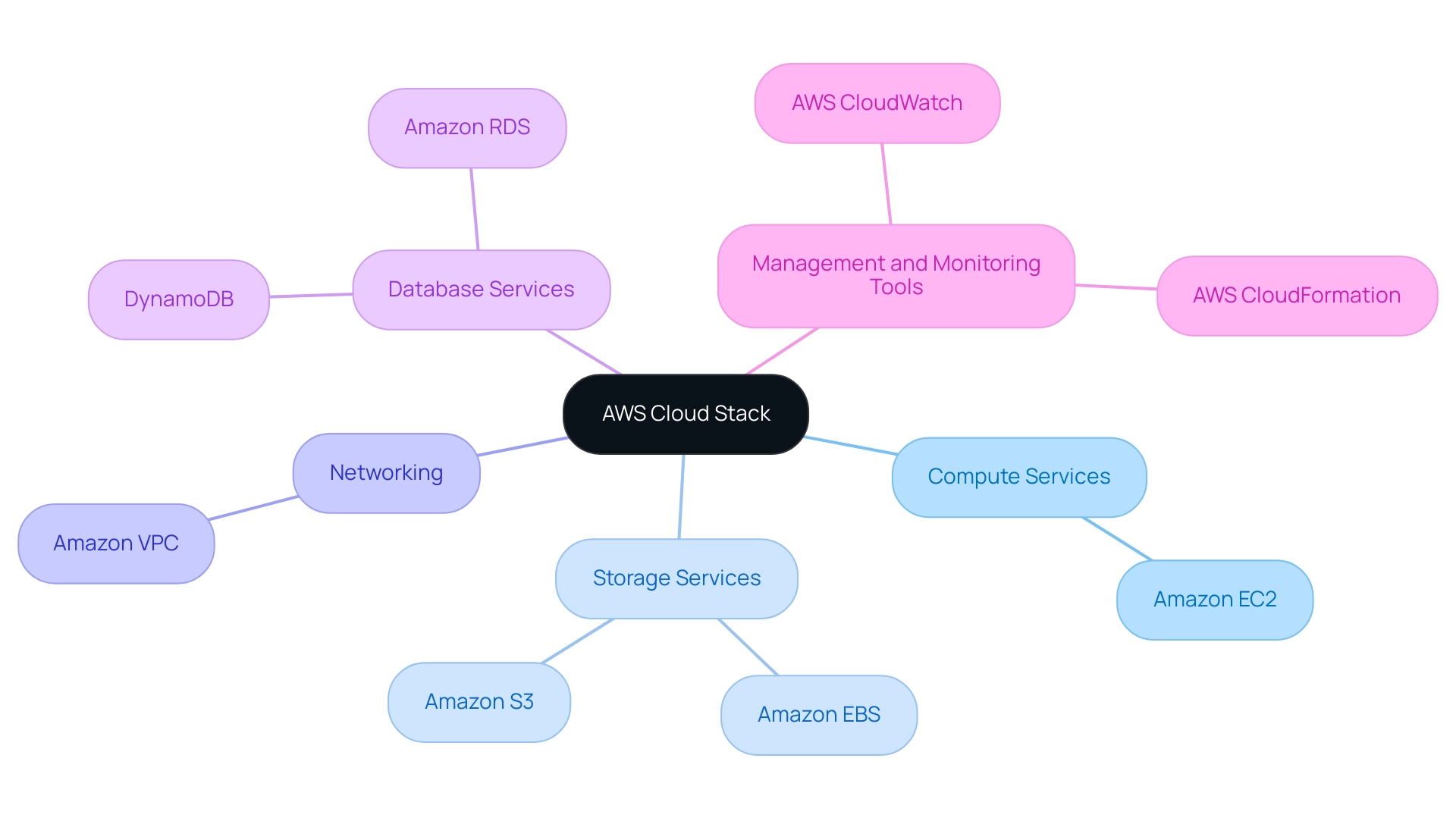
Benefits of Implementing an AWS Cloud Stack
The adoption of an AWS cloud stack offers numerous advantages for organizations, especially in the evolving landscape of 2024. Key benefits include:
- Scalability: Organizations can effortlessly scale their resources in response to fluctuating demands, ensuring optimal performance without unnecessary expenditure.
This is underscored by the case of Six Nations Rugby, which leveraged AWS to enhance data collection and analysis, resulting in a remarkable 40% improvement in the accuracy and timeliness of insights delivered to teams and fans.
- Expense Efficiency: With a pay-as-you-go pricing model, businesses only incur expenses for the resources they utilize, significantly minimizing overheads.
Recent insights reveal that half of surveyed companies are turning to online computing as a modern data protection strategy, recognizing the cost savings associated with AWS implementations. This shift not only highlights the financial benefits but also emphasizes the role of the AWS Cloud Stack in disaster recovery, further solidifying its position as a reliable solution for contemporary business challenges.
-
Flexibility: The extensive selection of services allows entities to tailor their cloud architecture to meet specific operational requirements, optimizing their technological investments.
-
Enhanced Security: AWS provides a range of robust security features and compliance certifications, ensuring that entities can effectively protect sensitive data.
-
Faster Time to Market: The availability of a broad range of pre-built services enables organizations to deploy applications swiftly, thereby enhancing their competitive positioning in the market.
Furthermore, the Post Graduate Program in Cloud Computing offers live sessions on AI trends, equipping professionals with the skills needed to effectively leverage the AWS Cloud Stack.
As Cody Slingerland aptly noted,
Combined, these two regions account for 82% of the world’s cloud computing,
underscoring AWS's dominance and reliability as a cloud service provider in the industry.
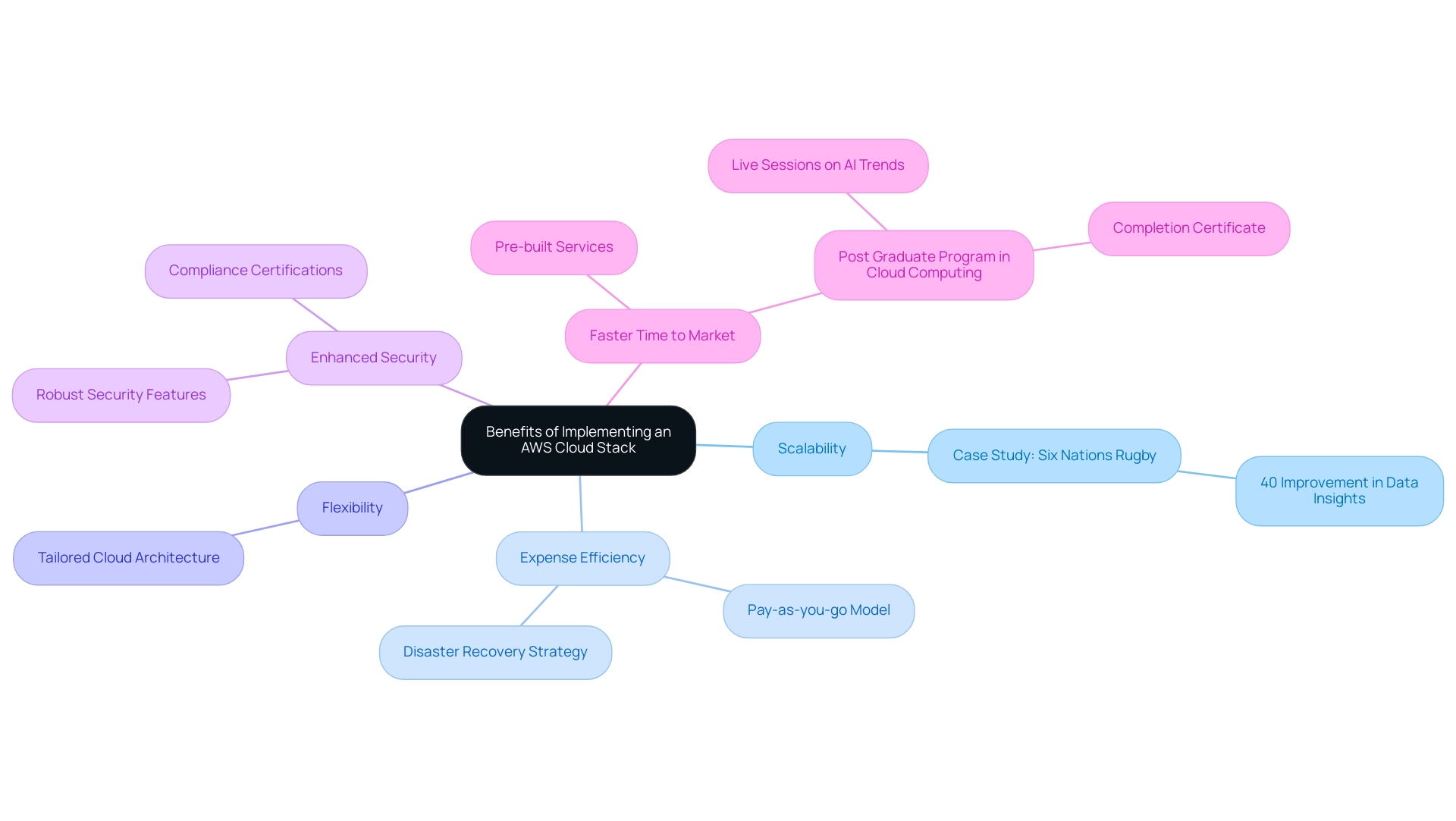
Best Practices for Managing Your AWS Cloud Stack
To effectively manage the aws cloud stack, it is essential to adopt several best practices that enhance operational efficiency and financial effectiveness. Key recommendations include:
-
Regularly Monitor Costs: Leverage AWS Cost Explorer to meticulously track expenditures and uncover potential savings across your AWS accounts.
The AWS Optimization Hub offers a comprehensive view of savings recommendations across AWS Regions and accounts, tailored to your specific usage patterns. -
Implement Security Best Practices: Conduct routine reviews of your Identity and Access Management (IAM) policies and enable multi-factor authentication to bolster security measures against unauthorized access.
-
Automate Infrastructure Management: Employ AWS CloudFormation to implement infrastructure as code, which significantly streamlines deployment processes and minimizes human error. Automation not only enhances efficiency but also reduces operational overhead.
-
Optimize Resource Usage: Consistently analyze resource utilization metrics, adjusting instance types or sizes to align with actual demands, thereby preventing over-provisioning and excessive expenses. For example, organizations using NetApp Cloud Volumes ONTAP have reported over a 70% decrease in storage expenses through advanced storage management techniques, illustrating the effect of careful resource management.
Additionally, consider leveraging Amazon EC2 Reserved Instances, which offer significant billing discounts compared to on-demand instance pricing, further enhancing cost efficiency. -
Stay Informed: Continuously monitor AWS updates and new service offerings to leverage the latest features and enhancements, ensuring your cloud infrastructure remains competitive and optimized.
By adhering to these best practices, entities can not only enhance their resource management strategies but also position themselves to capitalize on the evolving capabilities of the AWS cloud stack.
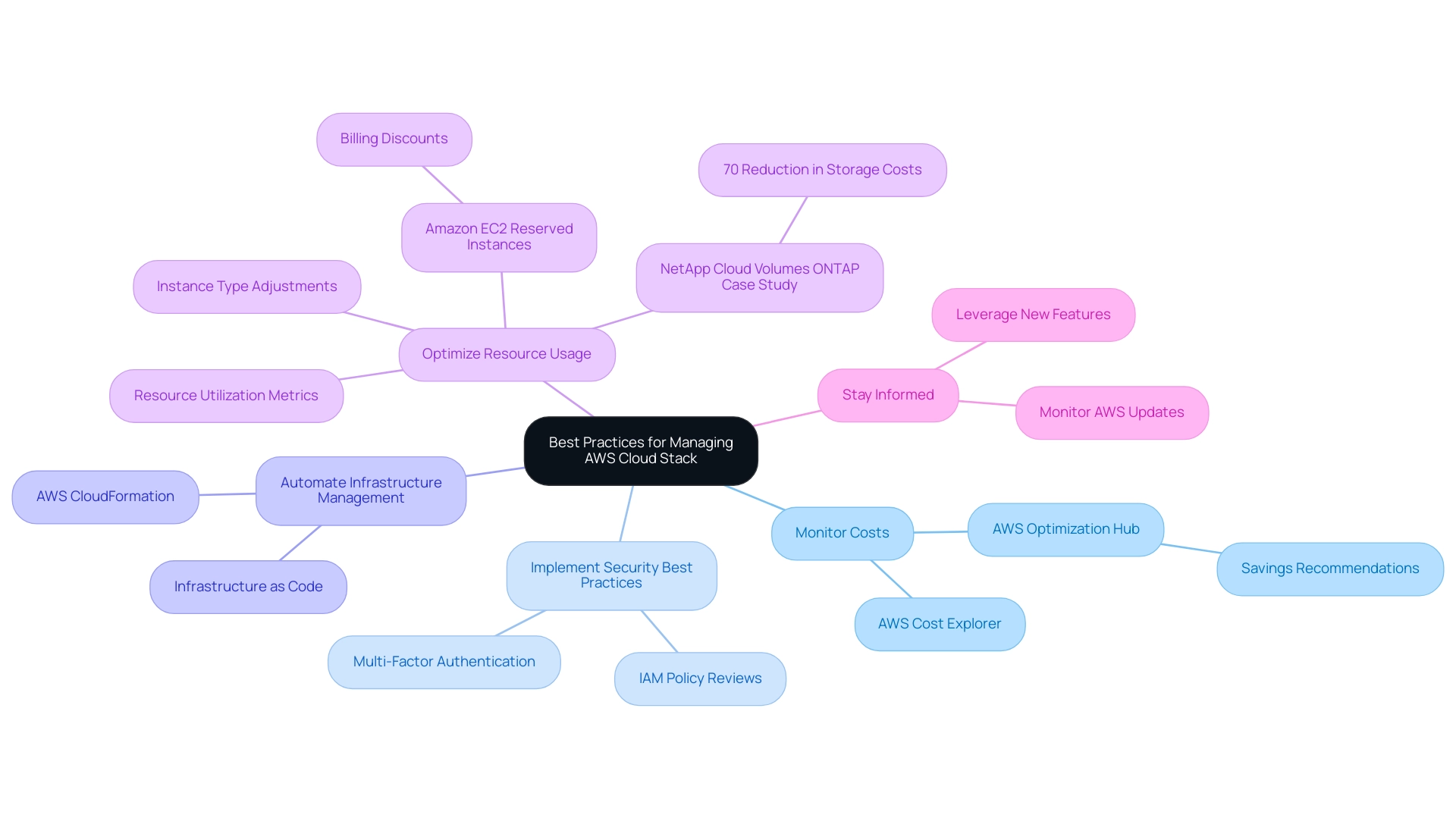
Challenges and Solutions in AWS Cloud Stack Management
Managing the AWS Cloud Stack presents various challenges that require strategic approaches to ensure efficient operation and cost-effectiveness. Key challenges include:
-
Complexity of Services: The extensive range of AWS offerings can be daunting, leading to confusion and inefficiencies.
To mitigate this, companies should invest in comprehensive training programs and leverage the AWS cloud stack documentation to empower their teams. -
Cost Management: Unexpected expenses related to online services are common.
Setting up billing notifications and performing regular usage assessments can assist organizations in managing their expenses. For instance, Drift successfully lowered its yearly expenses related to online services by $2.4 million through effective cost management strategies, while Applause experienced a 23% decrease in spending by optimizing their usage. -
Security Risks: The rise in online service adoption often correlates with heightened security vulnerabilities.
Implementing robust security protocols and performing regular audits are crucial steps in safeguarding sensitive data. -
Performance Optimization: Achieving optimal performance can prove challenging.
To address this, entities should consistently monitor performance metrics and adjust resources dynamically to meet fluctuating demands. -
Vendor Lock-In: Sole reliance on AWS may lead to vendor lock-in, which can restrict flexibility.
Adopting a multi-provider strategy can diversify infrastructure, allowing entities to leverage the strengths of different suppliers.
As Gartner notes,
Google Cloud’s IaaS offering is growing the fastest at 63.7%, illustrating the competitive landscape that necessitates effective management strategies.
In 2024, organizations will increasingly face these challenges as global energy consumption by cloud data centers, particularly within the AWS cloud stack, is projected to account for 1% of the world's energy utilization, highlighting the importance of sustainability in the context of AWS management.
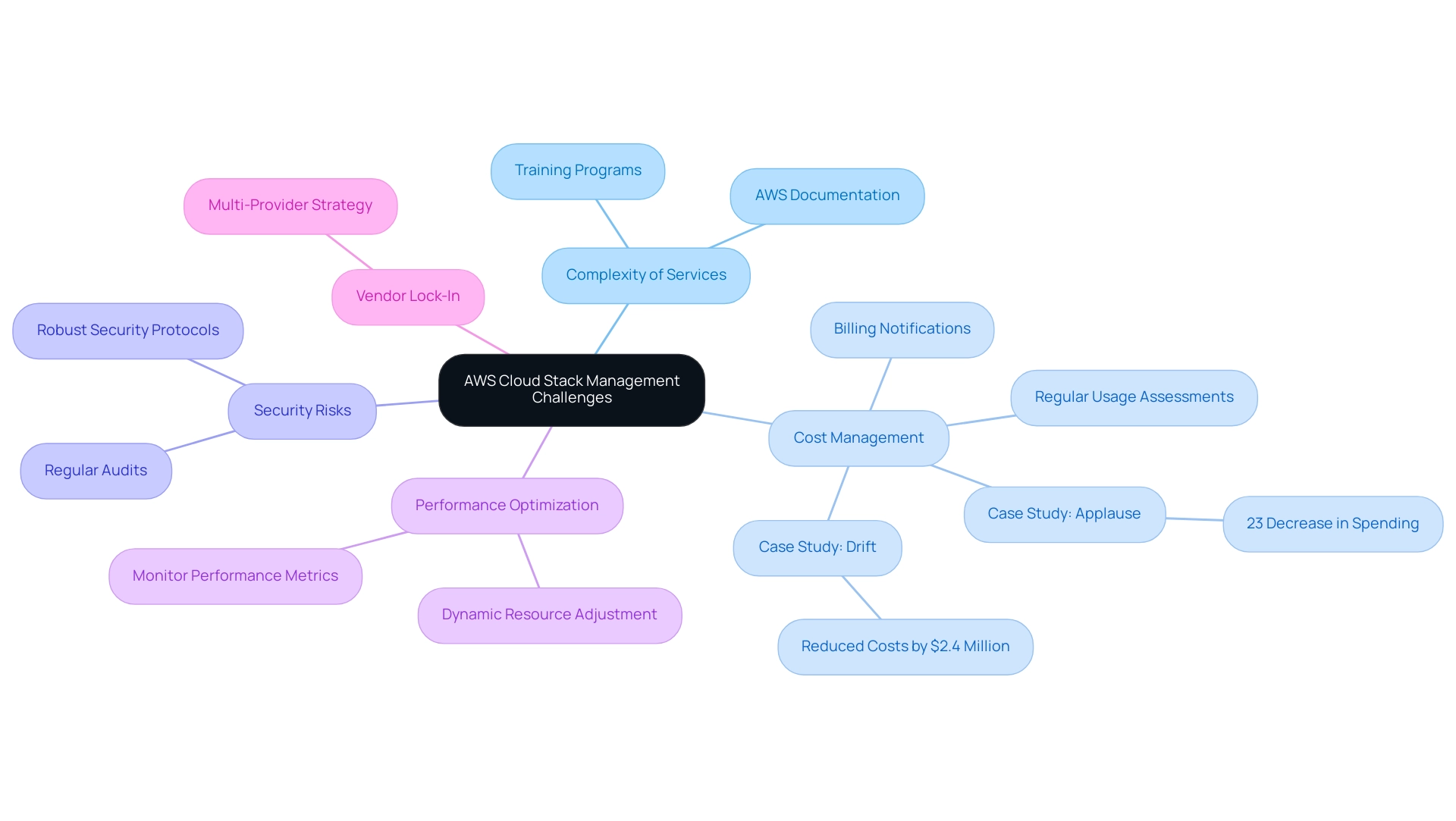
Conclusion
The AWS Cloud Stack stands as a pivotal resource for organizations navigating the complexities of cloud technology. Its comprehensive suite of services—from computing and storage to networking and security—provides a robust foundation for businesses aiming to harness the full potential of cloud computing. By embracing the AWS Cloud Stack, organizations can achieve significant benefits, including enhanced scalability, cost efficiency, and security, all of which are critical in the rapidly evolving digital landscape.
Implementing best practices for managing the AWS Cloud Stack is essential to maximizing its advantages. Regular monitoring of costs, automation of infrastructure management, and adherence to security protocols not only streamline operations but also safeguard sensitive data. Organizations that proactively address these management challenges are better positioned to optimize their cloud environments and mitigate risks associated with complexity and vendor lock-in.
As the cloud continues to dominate the data landscape, the relevance of the AWS Cloud Stack will only grow. With projections indicating that a substantial portion of data will reside in the cloud by 2025, organizations must prioritize effective cloud management strategies. By leveraging the capabilities of AWS, businesses can enhance their operational efficiency, drive innovation, and maintain a competitive edge in their respective industries. Embracing these insights will empower organizations to navigate the future of cloud computing with confidence and agility.




